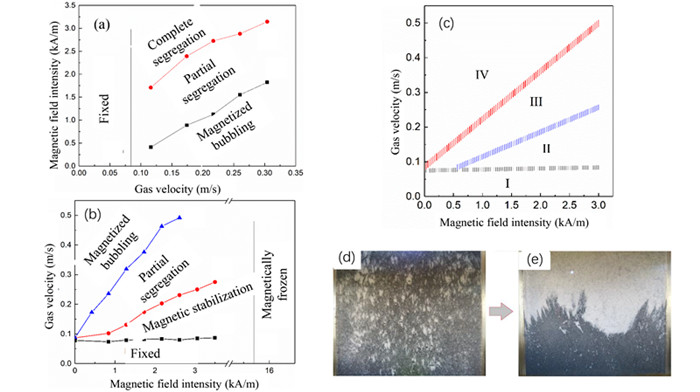Scientist Reveal Mechanism of Flow Regime Transition in Magnetized Fluidized Bed Reactor
The magnetized fluidized bed reactor (MFBR) is an integration of the bubbling fluidized bed reactor (BFBR) and the electromagnetic field. It is usually applied to deal with various gas-solid heterogeneous reactions.
The MFBR with the binary admixture of magnetizable and nonmagnetizable particles can be called the admixture MFBR. There are two modes to operate the MFBR: magnetization-FIRST and magnetization-LAST.
Recently, the research team led by Prof. HUANG Qingshan from Qingdao Institute of Bioenergy and Bioprocess Technology (QIBEBT), Chinese Academy of Sciences (CAS), has thoroughly investigated MFBR features and regime transitions.
The flow regime transitions of the admixture MFBR under the two operation modes are clearly revealed by drawing the operational phase diagrams, which are shown in Fig. 1a and b. It is found that the flow regime transitions are different for the two operation modes.
The state of the admixture MFBR in the operating zone II (Fig. 1c) depends not only on the magnetic field intensity and gas velocity but also on their application sequence (i.e., operation mode). Under the magnetization-FIRST operation mode, the bed state is magnetic stabilization (Fig. 1d) while it is complete segregation (Fig. 1e) under the magnetization-LAST operation mode.
This phenomenon results from the fact that the magnetic stabilization state is a metastable equilibrium state. As a metastable state, the magnetic stabilization state can be only obtained under the magnetization-FIRST operation mode.
The admixture MFBR in the magnetic stabilization flow regime combines the advantages of the BFBR and the fixed bed reactor and is especially suitable for dealing with the various gas-solid contact processes. The work clearly shows how to obtain the magnetic stabilization flow regime and provides useful guidance on the operation of the admixture MFBR.

Fig. 1 Flow regime transition of the admixture MFBR (Image by ZHU Quanhong)
(Text by ZHU Quanhong)
Contact:
CHENG Jing
Qingdao Institute of Bioenergy and Bioprocess Technology, Chinese Academy of Sciences
Tel: 86-532-80662647
E-mail: chengjing@qibebt.ac.cn